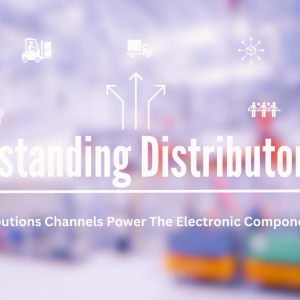For the electronic component industry, change remains the only constant. Our industry continually evolves to keep pace with rapid technological advancements and new discoveries. Our industry also continually adapts to fluctuating supply chains and lead times. The ability to adapt sets successful manufacturers, OEMs, and distributors apart.
In this article, we continue our series on Channel Marketing. We’ll delve into the current shift towards direct channels and explore the reasons behind this trend. As we highlight pain points manufacturers and OEMs experience with direct channels, we offer actionable steps that successful distributors take to not only survive the shifting paradigm but thrive.
The Rise of Direct Channels: A Paradigm Shift in the Electronics Industry
Manufacturers and OEMS historically relied on traditional distribution channels, long the backbone of the electronic component supply chain, for their sales and procurement needs. Authorized, or franchised, distributors acted as intermediaries between manufacturers and OEMs.
The rapid shift towards e-commerce, especially over the last few years, now challenges the traditional distribution channel model. Now, more manufacturers and OEMS turn their attention and resources towards developing more direct channels. Manufacturers are investing in the digital platforms necessary to bypass distributors and sell their products directly to OEMs.
Why Direct Channels Appeal to Manufacturers and OEMs
To remain relevant within our industry and survive the increased focus on direct channels, distributors must understand the reasons behind the shift. Only when distributors understand the forces and benefits driving this paradigm chain can they adapt and develop processes to better serve manufacturers and OEMs.
So, what drives this shifting emphasis on direct channels?
One key driver behind the direct channel trend stems from globalization and evolving technologies that support user-friendly online buying platforms. Some Manufacturers and OEMs may view direct channels as more profitable. Eliminating the middleman shifts the profit margin in a manufacturer’s or OEM’s favor. New commerce products continue flooding the market, offering manufacturers and OEMs new opportunities to jump into sales. Unfortunately, these products rarely include the logistics and support services offered by distributors.
Direct channels also appeal to Manufacturers and OEMs, who may also perceive direct channels as opportunities for more control over their brand image, pricing strategies, and market positioning. Others approach direct channels as opportunities to develop firsthand insights into customer preferences and industry trends. Manufacturers and OEMs must remember, however, that handling sales internally comes with customer support and logistics obligations that may require significant investment in staffing, infrastructure, and process development.
Direct Channel Challenges That Manufacturers and OEMs Cannot Afford To Ignore
While direct channels offer some unique advantages to manufacturers and OEMs, there are also significant challenges they encounter in this transition.
When manufacturers and OEMs forego authorized distribution channels in favor of direct channels, they often experience:
- Logistical Complexities
- Customer Support Issues
- Inconsistent Global Reach
- Demanding Inventory Management
Historically, manufacturers and OEMs looked to their authorized distributors to hire and train the staff necessary to circumvent or handle many of the above issues. Direct channel reliance puts the onus for these challenges squarely back on the shoulders of manufacturers and OEMs.
Cumbersome Logistics
Logistical complexities create cumbersome steps for manufacturers and OEMs now responsible for tracing and authenticity documentation. For many companies, this requires investment in systems capable of finding and storing this documentation. For complex projects requiring lengthy BOM lists, from multiple vendors, or across different regions, untangling source tracing and establishing requires additional dedicated staff.
Difficulty Getting – and Giving – Customer Support

Providing and obtaining customer support and expertise also creates new hurdles for manufacturers and OEMS focused on developing new direct channels. From a procurement standpoint, distributors offered manufacturers and OEMS invaluable technical expertise when sourcing components and seeking alternatives. Distributors traditionally provide support for the products they sell, and such support may not be fully in place when manufacturers and OEMs attempt direct channel procurement.
Providing customer support also often fell to authorized distributors. Manufacturers and OEMs focused on product development and production, leaving sales and follow-up support to their distribution partners. New direct channel practices mean these manufacturers and OEMs must now hire and train staff capable of ensuring buyer satisfaction and repeat business.
Inconsistent Global Reach
Manufacturers and OEMs transitioning to more direct channel reliance often struggle to establish a global reach comparable to well-established distributors. While distributors benefit from a wide network of customers and partners, manufacturers and OEMs in the early stages of direct channel development may experience inconsistencies in the absence of an established network of partners.
Inventory Management
Manufacturers and OEMs may need to adapt their inventory management practices to more effectively cope with varying lead times and availability issues when sourcing directly from manufacturers. While distributors could tap into alternative sources to maintain essential supply chains in the face of supply challenges,
Empowering Distributors in the Age of Direct Channels
Despite the challenges, proactive electronic component distributors recognize opportunities to bolster their business while embracing shifts in supply chain management. When direct channels offer competitive pricing, once available only through the bulk procurement practices of established distributors, these same distributors look for new opportunities to add value and improve services.
Distributors across every tier are investing in a variety of service offerings that differentiate individual distributors within a competitive marketplace. Distributor services often fill important gaps that would otherwise require manufacturers to hire additional staff or, in some cases, create entire new departments.
For distributors feeling the pressure of direct channel development on their bottom lines, the following steps represent opportunities to respond to supply chain challenges with strength.
Related: Understanding Distributor Tiers: How Distribution Channels Power The Electronic Component Industry
Strengthen Technical Expertise
By offering value-added technical services, distributors differentiate themselves and become indispensable partners to manufacturers and OEMs. Through their technical services, distributors assist with component selection and integration.

This expertise proves particularly important when manufacturers and OEM projects require difficult-to-source parts. Deep product knowledge and a thorough understanding of competing products qualify distributors to provide alternative products or components that meet a manufacturer’s or OEM’s unique specifications.
To develop as technical experts, distributors invest time and money into their technical support teams. They seek out and provide comprehensive training to understand the latest technology and components thoroughly. The ability to provide partner manufacturers or OEMs with technical recommendations creates value within these relationships that many manufacturers and OEMs cannot find from direct channel sources.
Component Authenticity and Transparency
As the risk of counterfeit components persists, distributors offer manufacturers and OEMs invaluable quality control and transparency. Authorized electronic component Distributors quickly enhance their value through services such as transparency documentation. These services allow manufacturers and OEMs to trace their components to the source, guaranteeing authenticity. For sensitive contracts, such as those in the government or aerospace sectors, the ability to provide traceability documentation may be the deciding edge that wins a manufacturer or OEM the contract.
Additionally, many OEMs and manufacturers tap into powerful branding opportunities through supply chain transparency. When developing products for conscientious audiences, manufacturers and OEMs often require thorough documentation and complete transparency throughout their supply chain. For these companies, essential product specifications may extend to include considerations such as product origin, manufacturing facility conditions, and sustainability practices.
Distributors capable of delivering a high degree of transparency with well-documented product tracing often rely on technology. Investing in the hardware and software tools necessary to create such transparency quickly sets a distributor apart from the field.
Enhance Inventory Management Solutions
Presently, many distributors face inventory excess challenges. As the industry struggled through the last two years’ delays, shortages, and backorders, many customers placed orders in advance to circumvent lost production time waiting for components. Some manufacturers and OEMs adopted more generous stocking habits.
Manufacturers and OEMs now need to align procurement and supply chain procedures with a just-in-time mentality as the electronic component industry continues to recover. Without a well-developed network of solid distributors to rely on, these manufacturers and OEMs accept great risk of lost production time and delays in time to market when they ignore distribution channels in favor of direct channel procurement.
Distributors should focus on optimizing their inventory management systems to ensure efficient handling of component availability and lead times. Implementing advanced analytics and forecasting tools can help predict demand patterns, reducing the risk of stockouts or overstocking.
If you’re looking for B2B components and parts, search over 300 million products from many sources here!
Electronic Component Distributors Approach Challenges As Opportunities With Mectronic
A seismic shift in the electronic component industry points to the rise of direct channels. While this transformation poses challenges for traditional distributors, it also opens doors to innovation and growth.
By embracing a customer-centric approach, strengthening technical expertise, enhancing inventory management, and building strategic partnerships, electronic component distributors can navigate these changes successfully. By adapting to the evolving landscape, distributors can continue to play a vital role in the electronics supply chain, offering valuable services and ensuring seamless connectivity between manufacturers, OEMs, and end-users.
Mectronic remains committed to supporting the partnerships that power our industry. In addition to our part search tools, Mectronic offers a host of services and solutions. Visit our website today to learn more about how Mectronic solutions empower distributors to overcome supply chain shifts and thrive in the electronic component marketplace.
Interested in the latest trends and innovations in technology? The Mectronic blog is your source for trusted insight into the technology world. Check our blog for regular updates!

Mectronic has been connecting sellers and buyers for 25 years. With powerful search tools and over 2 billion products, Mectronic helps you find the B2B components you need from sources you trust. Find the parts and components you need today here!





